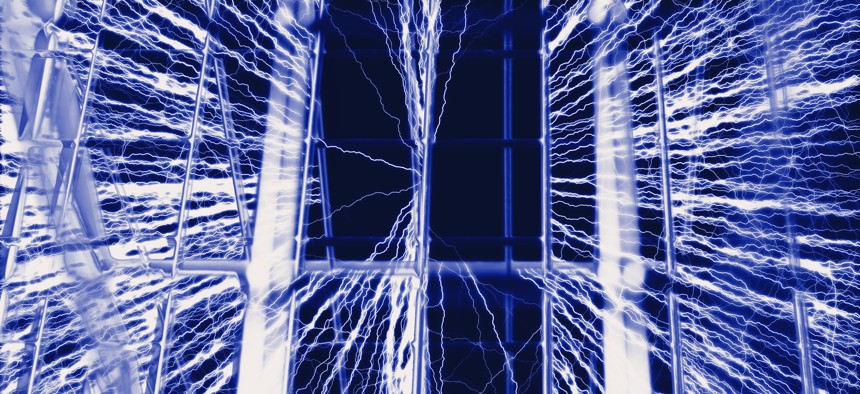
an artistic representation of a Faraday cage SHUTTERSTOCK / OPIS ZAGREB
A New Material Promises NSA-Proof Wallpaper
A Utah company has a new nickel-carbon material that could help the Pentagon fight off some of its most haunting threats.
Your next tinfoil hat will won’t be made of tinfoil. A small company called Conductive Composites out of Utah has developed a flexible material — thin and tough enough for wallpaper or woven fabric — that can keep electronic emissions in and electromagnetic pulses out.
There are a few ways to snoop on electronic communications. You can hack into a network or you can sniff out radio emissions. If you want to defend against the latter, you can enclose your electronic device or devices within a structure of electrically conductive, (probably metallic) material. The result is something like a force field. The conductive material distributes the electromagnetic energy away from the target in every direction — think of the *splat* you get when you hurl a tomato at a wall. These enclosures are sometimes called Faraday cages after the 18th-century British scientist who discovered electrolysis.
Today, Faraday cages are all over the place. In 2013, as the College of Cardinals convened to elect a new Pope, the Vatican’s Sistine Chapel was converted into a Faraday cage so that news of the election couldn’t leak out, no matter how hard the paparazzi tried, and how eager the cardinals were to tweet the proceedings. The military also uses Faraday cages for secure communications: Sensitive Compartmented Information Facilities or SCIFs are Faraday cages. You’ll need to be in one to access the Joint Worldwide Intelligence Communication System, or JWICS, the Defense Department’s top-secret internet.
Related: Pentagon Moves More Communications Gear into Cheyenne Mountain
Conductive Composites has created a method to layer nickel on carbon to form a material that’s light and moldable like plastic yet can disperse energy like a traditional metal cage.
The material also holds promise for a scalable defense against an electromagnetic pulse weapon. EMPs are a rising concern for the national security community, but not a new one. Soviet research into electromagnetic pulse weapons goes back to 1949, and active experimentation back to the 1970s. EMPs entered the public eye via the 2005 James Bond movie GoldenEye, in which an EMP caused massive blackouts and widespread fried electronics. Two years later, Army Lt. Gen. Robert Schweitzer testified before the House Joint Economic Committee that such weapons might help fulfill Sun Tzu’s dictum to conquer an enemy without fighting. “If you can take out the civilian economic infrastructure of a nation, then that nation, in addition to not being able to function internally, cannot deploy its military by air or sea, or supply them with any real effectiveness,” he said. Translation: EMPs offer all the victory at a fraction of the cost.
In May, the Air Force confirmed that it was working on an electromagnetic pulse weapon of its own. A Faraday cage can serve as protection against exactly that sort of attack.
But the principal military application of the Conductive Composite material —aside from being able to enclose data centers in suitcases rather than guarded basement warehouses — could be to harden drones against electronic attack, a breakthrough that could pose a problem when the drones aren’t U.S.




